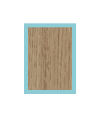Laminates compared - MFC versus HPL

Melamine Faced Chipboard (MFC) and High Pressure Laminates (HPL) look similar but have different uses.
We make most of our cabinets from MFC (but also offer MDF, veneers, HPL and other materials as needed).
Often people refer to MFC as ’laminate’ but there is an important distinction to be made.
MFC is indeed a type of laminate in the class of materials known as ‘Low Pressure Laminate’ (LPL).
As one might expect there is also a class of materials that are ‘High Pressure Laminate’ (HPL).
Both LPL and HPL use the melamine chemical and the difference between the two are how they are manufactured but we will focus here on their applications.
HPLs are the decorative surfaces commonly used in kitchen worktops and doors where a hard-wearing material is required. Sometimes cabinetry for commercial applications (healthcare, schools) is required to be made from a HPL.
Since HPL looks the same but is more hard-wearing, shouldn’t all furniture use HPL instead of MFC? Not really because of these two reasons:
the increased manufacturing costs and increased raw material usage of HPL make it more expensive
MFC is still a relatively hard-wearing material which is more than good enough for most applications.
For example compared to painted surfaces MFC is far more hard-wearing which is why we always recommend MFC instead of painted for internal shelves.
The vast majority of cabinetry available both bespoke and non-bespoke is made from MFC. Fortschritt Bespoke Cabinetry as a bespoke maker can make cabinetry using MFC or HPL according to the requirements.
| MFC | HPL | |
|---|---|---|
| Laminate thickness | 0.1 | 0.7 |
| Durability | Good | Excellent |
| Range of finishes available | Excellent | Good |
| Availability | Available with chipboard core in 18/24/36mm thicknesses | Available as 0.7mm laminate |
| Manufacturing costs | Low | High |
When is HPL required ?
Commercial, educational or health furniture may require HPL. Table tops (especially where metal cutlery will be used) should use HPL. However an item like a dressing table top may experience relatively light usage so we have encountered situations where the customer preferred a gloss acrylic material.
If you require HPL ensure that is what you are getting
The differences between MFC and HPL can sometimes go unrecognised because they look almost identical. For example:
Customer : “Are your wardrobes good quality?”
Retailer : “Yes, they are very high quality”
Customer : “Can I use the top of the drawer unit as a table?”
Retailer : “Yes, should be okay”
Customer : “Is it made from High Pressure Laminate material”
Retailer : “The laminate is strong and high quality, look we use 18mm thick back panels”
Customer : “But is the unit made from High Pressure Laminate, commonly called HPL?”
Retailer : “I don’t know, what is HPL?”
